Lighting standards for cricket facilities can vary significantly from one community to another, and even between different types of cricket venues. For instance, a major cricket stadium that hosts televised matches will have more stringent lighting requirements to ensure optimal visibility for both players and viewers. Such venues typically need to meet high standards of brightness to accommodate television broadcasts and provide a clear, high-definition view of the game.
Cricket ground lighting standards are generally measured in lux and footcandles, which indicate the illuminance level required to achieve the desired visibility. These metrics are crucial because they help determine the appropriate lighting setup based on the specific needs of the cricket facility. The size of the cricket ground and the level of competition also play a significant role in influencing these lighting parameters. For example, professional stadiums need higher lux levels compared to local community grounds.
To better understand the lighting requirements for cricket fields, it’s essential to explore the concept of lux levels and how they apply to both indoor and outdoor cricket facilities. The following sections will provide detailed information on the appropriate light levels needed for various types of cricket venues. We’ll begin with an overview of what lux levels are and their significance in cricket lighting. Next, we’ll examine the specific lighting requirements for outdoor versus indoor cricket facilities. Finally, we’ll discuss the importance of regular maintenance to ensure optimal lighting conditions and explain how to accurately measure these lux levels to maintain high standards of visibility and performance.
Table of Contents
ToggleUnderstanding Lux
What is Lux?
In the realm of photometry, the lux (lx) is the standard unit of illuminance. It quantifies the amount of light that falls on a given area, such as a cricket field. Essentially, lux measures the intensity of light at a specific point on the field, providing a clear indicator of how well an area is illuminated.
When you position a light source in one location and move away from it, the intensity of the light diminishes. For a cricket field, achieving adequate brightness is crucial for players, including both batters and bowlers, to perform effectively. To ensure proper illumination across the entire field, multiple floodlights are strategically installed around the stadium. Determining the correct number and placement of these floodlights involves calculating the required lux levels to achieve uniform brightness.
Measuring Lux
To gauge the brightness on a cricket field, you will need to take lux readings. This is where a lux meter becomes essential. It measures the light intensity at specific locations to ensure that the lighting setup meets the desired standards.
One lux is defined as one lumen per square meter. While lumens indicate the total amount of light emitted by a source, lux provides a measurement of light distribution over a given area. This means that lux values can vary depending on the distance from the light source and the area being measured.
Key Points to Consider
The effectiveness of lighting in sports venues, such as cricket fields, relies on achieving optimal lux levels to ensure that players can see clearly and perform at their best. This requires not only proper installation of lighting fixtures but also accurate measurement and adjustment of lux levels to meet the specific needs of the field.
Lux Levels Required for Outdoor Cricket Stadium Lighting

General Requirements
For outdoor cricket stadiums, the lighting standards are categorized into different classes to cater to various levels of play and viewer expectations. It’s important to consider that lighting conditions will deteriorate over time, so the initial setup should exceed the minimum average lux values provided. Additionally, the light sources should have a Color Rendering Index (CRI) of 90 or higher, though a minimum of CRI 65 is acceptable to reveal colors and contrasts accurately on the cricket pitch. The uniformity gradient should be maintained below 20%, meaning the horizontal brightness should not vary by more than 20% between adjacent areas. For comfort, the maximum glare rating should not exceed 50 to prevent discomfort glare.
A useful conversion to remember is that 1 footcandle is equivalent to 10.76 lux.
Class I – 750 Lux
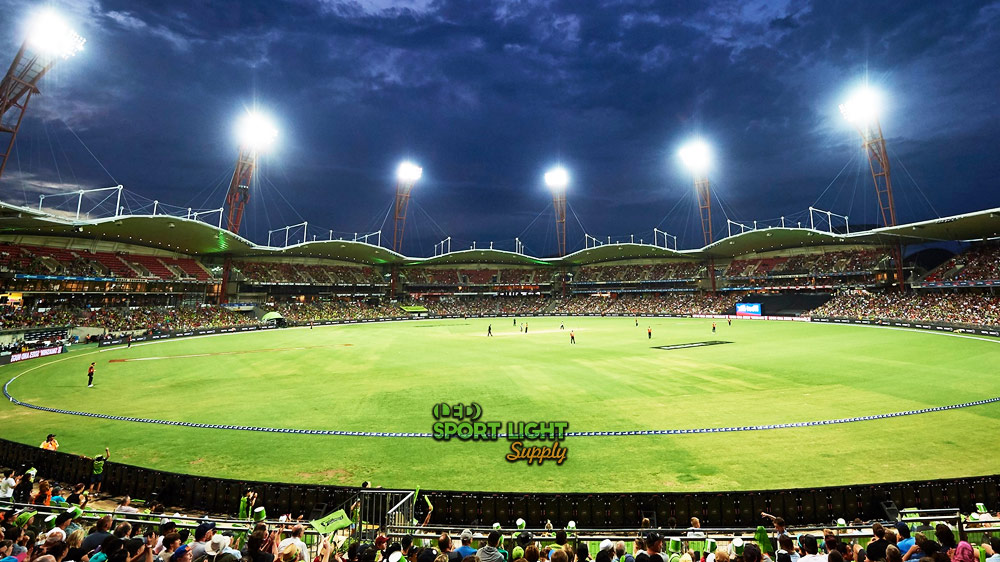
Class I lighting is intended for high-level international and domestic cricket matches, including Premier, First Class, regional, state matches, and top-level training. This standard is designed for large stadiums with extensive viewing distances and significant crowds. According to the EN 12193 lighting standard, the average illuminance on the cricket pitch should be 750 lux (69.70 footcandles). For the outfield, the average illuminance can be reduced to 500 lux (46.48 footcandles). The uniformity ratios for Class I are crucial to maintain consistent lighting across the field. Specifically, the U1 ratio, which measures the minimum illuminance compared to the average illuminance, should be 0.7 in the infield and 0.5 in the outer cricket ground. The U2 ratio, indicating the minimum illuminance compared to the maximum illuminance, must be 0.5 on the cricket pitch and 0.4 in the rest of the field.
Class II – 500 Lux
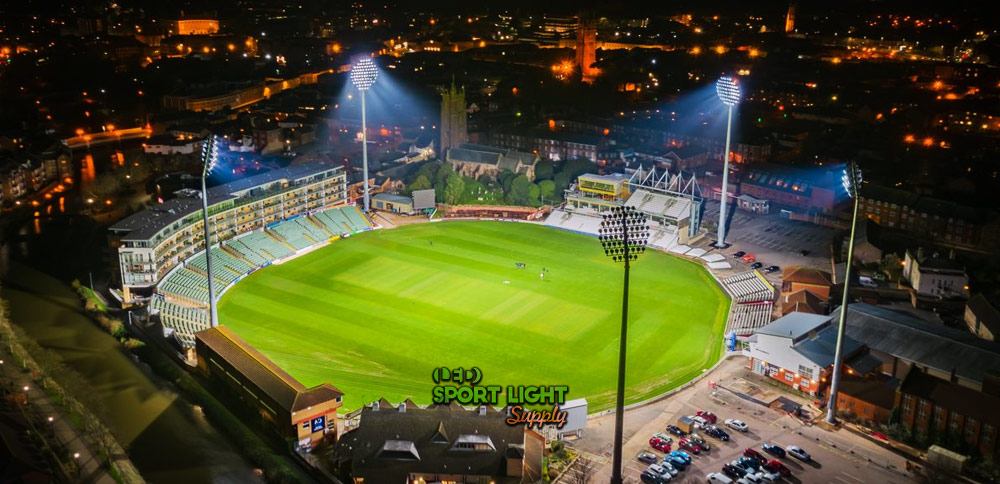
Class II lighting is suitable for club competitions and First Class training where television broadcasting is not required. This standard fits modest stadiums with medium viewing distances, often used for youth competitions and finals with a moderate crowd. Under the EN 12193 standard, the average illuminance in the square should be 500 lux (46.48 footcandles), and in the outfield, it should be 300 lux (27.88 footcandles). The uniformity ratios for Class II are similar to those for Class I. The U1 ratio should be 0.7 in the infield and 0.5 in the outfield, while the U2 ratio must be 0.5 on the cricket pitch and 0.4 in the rest of the field.
Class III – 300 Lux
Class III lighting is intended for local club competitions, recreational games, and training sessions. It is a basic standard suited for national youth competitions and smaller, less formal events with minimal spectator presence. According to EN 12193, the average illuminance in the square should be 300 lux (27.88 footcandles), and in the outfield, it should be 200 lux (18.58 footcandles). The uniformity ratios for Class III require a U1 ratio of 0.5 in the square and 0.3 in the outfield. The U2 ratio should be 0.5 in the square and 0.3 in the rest of the field.
Match Practice – 200 Lux
Match practice lighting is designed for training sessions for junior and senior players, where no spectators are present. This setup ensures safety and simulates official game lighting conditions. Typically, a basic 4-pole layout is sufficient for this purpose. For match practice, the required average lux is 200 lux (18.58 footcandles). The uniformity ratios for match practice should be a U1 ratio of 0.6 and a U2 ratio of 0.4. Maintaining consistent illuminance is essential during training to help players focus and improve their skills effectively.
Non-Body Contact Training – 100 Lux
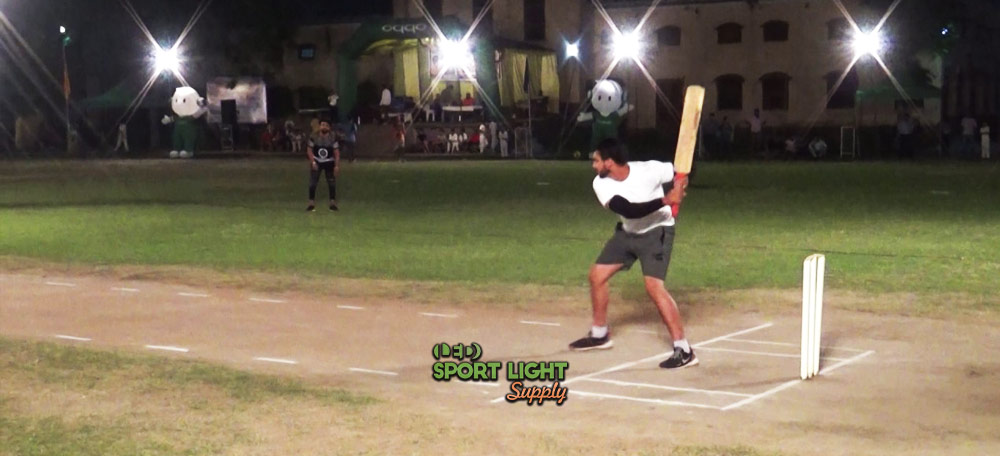
This lighting standard is intended for social activities or training sessions that do not involve high-risk factors or body contact. Examples include basic ball training or teaching sessions using visual aids. The average illuminance required for non-body contact training is 100 lux (9.29 footcandles). The uniformity ratios for this minimal standard should be a U1 ratio of 0.5 and a U2 ratio of 0.3. Regular testing is recommended to ensure that the lighting remains adequate for these activities.
Lux Level Requirements for Indoor Cricket Court or Practice Net Lighting

Indoor cricket courts and practice nets have specific lighting requirements to ensure safety and optimal play conditions. These standards vary based on the intensity of competition and the type of cricket ball used. The lighting criteria are designed for facilities with a ceiling height of 4.5 meters and a court size of 30 x 12 meters. The lux levels and uniformity ratios are adjusted according to the hardness of the ball used.
Class I
For international and national top-level competitions, the average illuminance required is 750 lux (69.70 footcandles), with a uniformity ratio (U1) of 0.7. This standard is appropriate for softer, modified cricket balls. However, when using a standard hard cricket ball, the lighting requirement increases significantly. In such cases, the average illuminance should be 1500 lux (139.40 footcandles) with a U1 ratio of 0.8. This higher level of illumination is crucial to ensure player safety and visibility during high-intensity play.
Class II
Regional and mid-level competitions require a minimum average illuminance of 500 lux (46.48 footcandles) with a U1 ratio of 0.7. This standard supports good visibility and player performance in less demanding settings. For higher lighting standards, particularly when using a hard cricket ball, the average lux should be 1000 lux (92.93 footcandles) with a U1 ratio of 0.8. This elevated illumination level caters to more competitive environments and enhances overall safety and performance.
Class III
For low-level or local club indoor use, the minimum average illuminance is set at 300 lux (27.88 footcandles) with a U1 ratio of 0.7. This standard is suitable for less formal or recreational play. When using a hard cricket ball, the lighting should be increased to at least 750 lux (69.70 footcandles) with a U1 ratio of 0.8. This adjustment ensures adequate visibility and safety during practice sessions or less competitive games.
The Importance of Maintaining Required Cricket Stadium Lighting Lux Levels
Proper lighting is crucial for cricket stadiums, influencing player performance, spectator experience, broadcast quality, and overall safety. Ensuring the correct lux levels helps maintain an engaging atmosphere, enhances visual clarity, and contributes to a safe environment for both players and spectators.
Better Vision for Cricket Players and Spectators
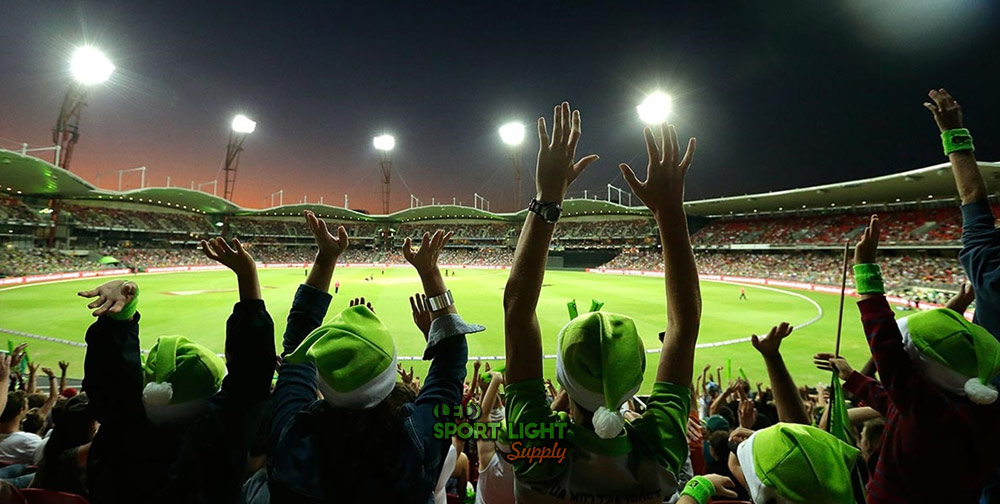
A well-designed lighting system enhances visibility, making the game more engaging for spectators and facilitating better performance from players. Proper illuminance levels eliminate glare, allowing players to see the ball clearly and perform optimally. This improved visibility aids umpires in making accurate decisions on plays such as byes, boundaries, and catches. Conversely, inadequate lighting can frustrate both the audience and the teams. Excessive brightness may necessitate additional shielding, leading to increased costs and potential disruptions to the game.
Better Picture Quality for TV Broadcasting
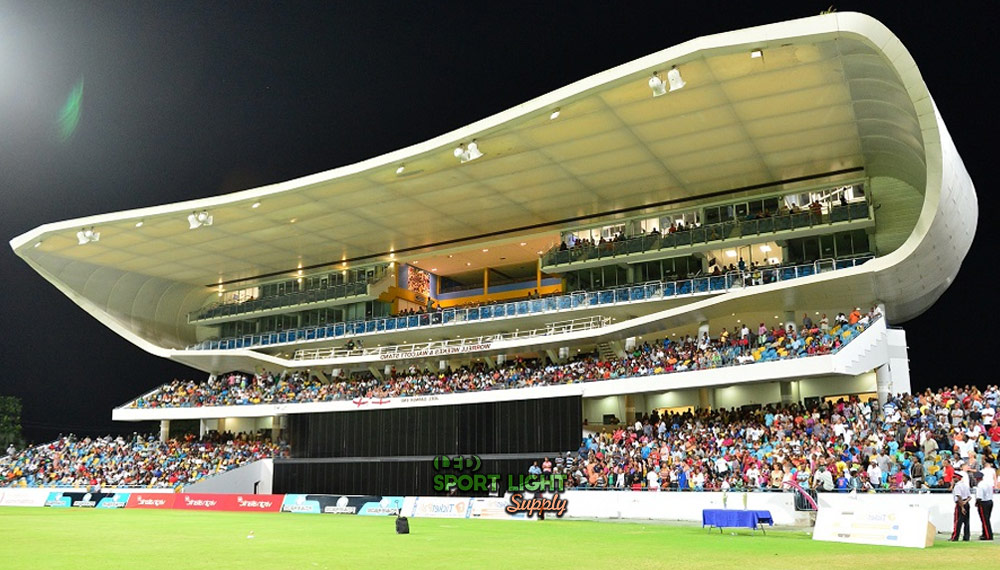
For television broadcasts, high-quality lighting is essential to capture clear and captivating images. Adequate illuminance on the cricket pitch ensures that broadcasts meet national standards and provide viewers with a detailed view of the game. Proper lighting allows for high-quality pictures and replays, which are crucial for audience engagement and accurate representation of the match. Multiple cameras from various angles require consistent and suitable lighting conditions to produce the best broadcast quality.
Creating an Atmosphere
The atmosphere of a cricket match significantly impacts the enjoyment of both players and spectators. Proper lighting ensures that the game is visible and engaging, preventing confusion that might arise from poor visibility. Maintaining consistent brightness throughout the match is essential, as changing light conditions can disrupt the flow of play and affect the players’ and spectators’ experience. An immersive atmosphere is achieved by preventing glare and maintaining uniform light intensity throughout the game.
Shadowless Illumination
Shadowless lighting is critical, especially for top-level competitions where visibility of the ball is paramount. Shadows from trees, nets, or other structures can hinder play and reduce visibility. Proper planning of lighting layouts, including the strategic placement of floodlights and spotlights, can mitigate shadow issues. Effective lighting design ensures that shadows are minimized, creating a clear and unobstructed view of the cricket field. High mast and flood lights are commonly used to achieve this, providing consistent illumination across the entire playing area.
Player Safety
Adequate lighting is vital for player safety, particularly in outdoor cricket fields where conditions may be uneven or hazardous. Proper illumination helps players spot potential dangers such as holes or wet areas on the field, reducing the risk of injuries. High-power LED lights, strategically positioned, ensure that players can see the entire field clearly, which is especially important for youth cricket programs. Good lighting helps prevent accidents and ensures a safer playing environment.
Security
Proper lux levels also contribute to the security of the cricket stadium. Well-lit areas deter potential theft and ensure that the stadium is safe for spectators and players. Automatic floodlights with dusk-to-dawn functionality can illuminate the cricket field during late-afternoon practices or when training in low-light conditions. Light sensors can help manage lighting in specific areas, ensuring visibility and safety during training sessions and preventing accidents or missed plays due to poor lighting.
How to Measure Lux Levels in a Cricket Stadium
Accurate measurement of lux levels in a cricket stadium is essential for ensuring optimal lighting conditions for players and spectators. There are two primary methods for measuring lux levels: using a dedicated lux meter and utilizing a smartphone app. Each method has its own advantages and applications.
By Lux Meter
The lux meter is the most commonly used tool for measuring illuminance in various lighting projects, including cricket stadiums. This instrument is designed to provide precise readings of light intensity across different areas of the field.
A typical lux meter consists of a photocell that detects luminous flux and converts it into an electric current. This current is then amplified to measure even very low brightness levels. Finally, a microammeter calibrated in lux provides an accurate reading of the light intensity.
To measure lux levels, the lux meter is placed at various points on the cricket field. The device must be positioned horizontally and remain undisturbed to ensure accurate readings. After collecting data from multiple points, you can calculate the average illuminance, as well as identify the maximum and minimum lux values. Periodic calibration of the lux meter may be necessary to maintain accuracy, and most models come with instructions for calibration or checking measurement accuracy.
By Smartphone App
For a more accessible and cost-effective method, you can use a smartphone app designed for measuring illuminance. These apps utilize the video camera sensors in your phone to estimate brightness levels.
To use a smartphone app, set up a grid of sampling points across the cricket field, typically in a 30x30ft pattern. Place your phone or lux app sensor on the ground at each point, ensuring it is completely horizontal and undisturbed. Record the lux readings from each location.
After gathering data from the various points, calculate the average illuminance and determine the maximum and minimum lux values. While smartphone apps provide a convenient way to measure lighting levels, they may not be as precise as dedicated lux meters and can be influenced by the quality of the phone’s camera sensors.
Conclusion
Once you have gathered all the lux readings for your cricket field, the next step is to perform the necessary calculations to ensure the lighting meets the required standards. For instance, you can convert the lux measurements to footcandles by dividing each reading by 10.76. Additionally, calculating the uniformity ratios U1 and U2 will help determine whether the lighting needs adjustment to avoid issues like uneven illumination.
